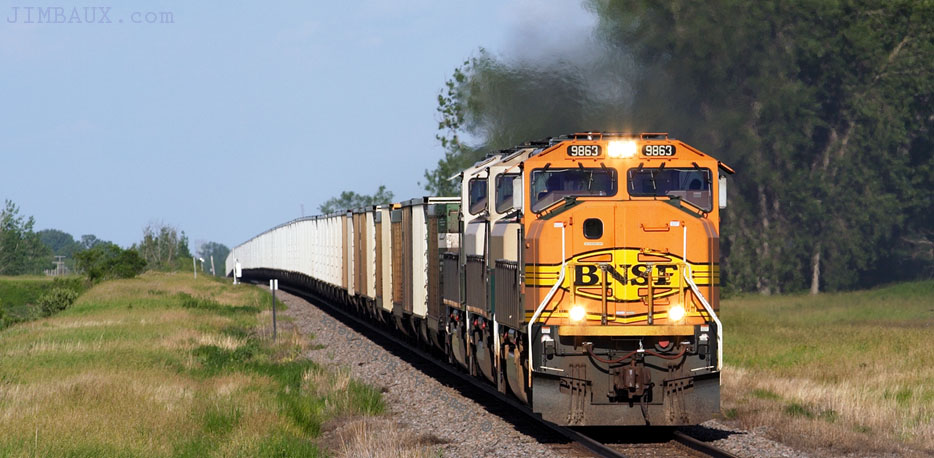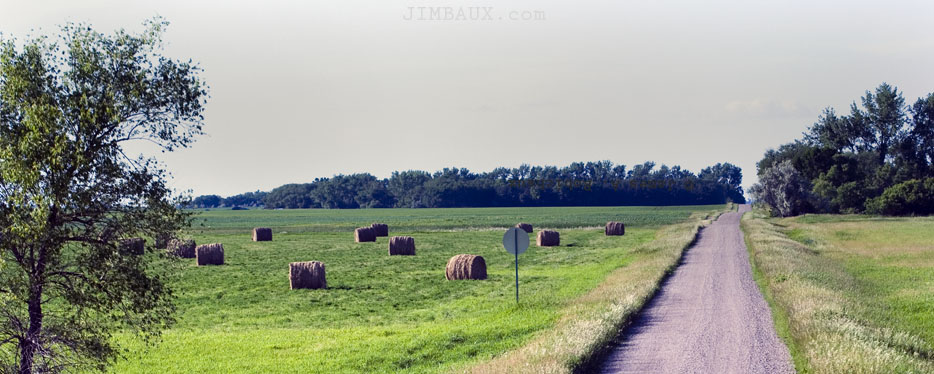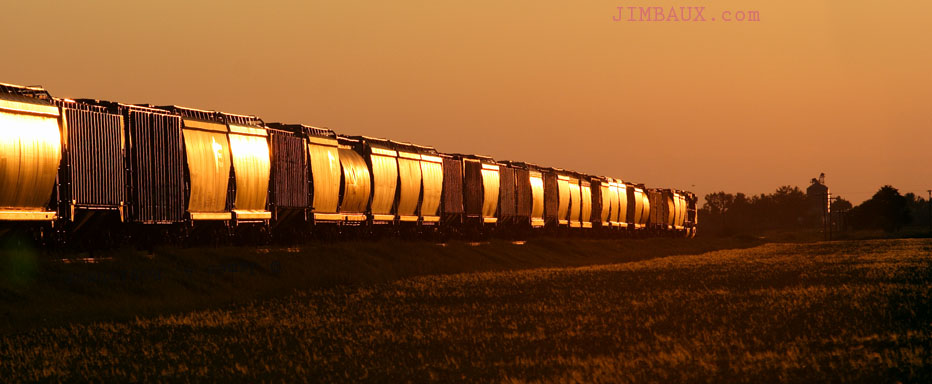[Jimbaux knows that when you’re on the edge and falling off, it’s all over for you.]
On the evening of Friday 29 June 2008 in North Dakota, Jimbaux photographed his first moving Canadian Pacific Railway train, making at least one train of all of the “Big 8” railroads of North America his photographic subjects, the second-to-last being a Ferromex train in Paredón, Coahuila, almost exactly a year-and-a-half before.
Our BNSF Appetizer
First, though, we have some BNSF train to chase out of Fargo after class, since we don’t pick up the CP’s former SOO Line until we get to Valley City. Coming out of Fargo, we have the E-BENABM1-24, an empty coal train on its way back to the Powder River Basin. Here is the train at Buffalo, North Dakota.
The E-BENABM is an empty coal train, hence the “E” prefix, from Breckenridge, Minnesota, hence the “BEN” origin station code, to Absaloka Mine, Montana, hence the “ABM” destination station code.
He slowed for a meet at a place called Kolduk, and this is one of my favorite views.
How’s that? I like it. The train that our westbound was meeting was a loaded coal train, a C-NAMSUD1-08 (North Antelope Mine, Wyoming, to Superior, Wisconsin), but none of the pictures of it are worthy of publication. However, you might like this northward view from the crossing.
Here’s something that TI over at Plains Folk might like.
I can’t even remember if the next shot is from the same crossing, but here’s our last view of the E-BENABM before we get to the prize CP stuff.
That’s almost certainly the same water tower in the above pictures. You North Dakota folks reading this, please help me fill in the details. Thanks.
Our CP Entree
Yes, since I have BNSF back home in Louisiana on the former SP Sunset Route – about the only part of the vast BNSF empire that is neither former Santa Fe nor former Burlington Northern – it isn’t all that exotic to me, even though coal trains, the real BN, and wide open plains are really cool to me; however, the Canadian Pacific Railway, even this part of it in the northern United States, is quite exotic. I don’t remember how I was alerted to the presence of this northbound-westbound loaded grain train, but once I caught the CP in Valley City, I kept going up the Sheyenne River valley northwest of town to set up for this really neat view.
And that, kiddies, is Jimbaux’s first ever shot of a Canadian Pacific Railway train! Yes, it just had to have a Union Pacific locomotive second, but at least it wasn’t leading. The above image, even though taken a few miles out of town, should also give you an idea of why Valley City is called Valley City! That’s not a hill in the background; things get quite flat once you get to the area where the horizon is in the picture, and that is where our BNSF pictures above were taken, well, miles to the east, but still at about the level of the top of the valley.
There is something that I am noticing now about the above picture that meant nothing to me when I took it and not until after I had visited the CP proper in British Columbia with BobE in the mid-summer of 2009. When I was in British Columbia, I noticed how CP didn’t seem to keep vegetation (mostly grass) from growing on the roadbed except for right around the track itself. Mainline railroads have ballast several feet deep on their roadbeds, and most railroads keep the slopes on either side free of vegetation. CP apparently doesn’t. See the above picture. Much of the CP mainline in British Columbia – particularly east of Kamloops – looks like that. Has anyone else noticed that? What’s the story behind this? Does CP have a no-weed-spraying policy?
When I mentioned this to BobE while we were in British Columbia along the CP, I don’t remember his exact words, but I think he said something along the lines of “you expected the mainline of the iconic railroad of Canadian nationalism to look a little more well-kept than that.” Yes, I did.
At the time that I took these pictures, I was a CP stockholder (though I sold all of the shares months later); I was here in North Dakota monitoring my investment! Well, not really, but that sounded good.
Anyway, west of this location, this part of the SOO Line – now CP’s Carrington Subdivision – begins a climb out of the Sheyenne Valley toward Carrington and eventually the Canadian border (a few hundred miles away), and I made my last stand before the town of Rogers at dusk as the engines were howling quite loudly and moving at no more than about 20mph this heavy grain train out of the valley.
Yes, the time is after 21:00, and I’m still taking pictures using the light of the sun! That’s how it goes so close to the summer solstice so far away from the Equator.
That’s a good enough way to end the day and this post, don’t you think? Unfortunately, I wouldn’t get much more CP action – if any at all – in this glorious summer in the Northern Great Plains. I had other great experiences there, though.
All for now . . .
Jimbaux









{ 2 comments… read them below or add one }
I grew up in Valley City, so it is nice seeing photos taken in that area. In one of your captions you mention a place Kolduk. The correct spelling in Koldok, and it is pronounced “coal dock”. In later steam days, the NP maintained a large 300 ton capacity all steel Ogle coaling tower at this location. It undoubted replaced a wooden coal dock at some point.
The last photo of the E-BENABM was taken at the east crossing of the town of Oriska. Also, do you remember the specific location of your first photo of the CP train? I like that angle and don’t know where it is.
You must log in to post a comment.